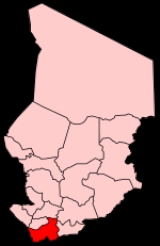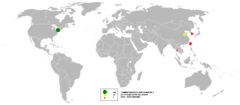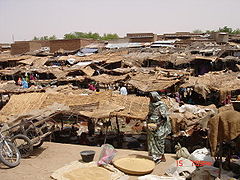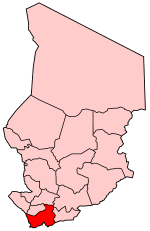
Economy of Chad
Encyclopedia
Landlocked Chad
's economic development suffers from its geographic remoteness, drought, lack of infrastructure, and political turmoil. About 85% of the population depends on agriculture
, including the herding of livestock
. Of Africa's Francophone countries, Chad benefited least from the 50% devaluation of their currencies in January 1994. Financial aid from the World Bank
, the African Development Bank
, and other sources is directed largely at the improvement of agriculture, especially livestock production. Because of lack of financing, the development of oil field
s near Doba
, originally due to finish in 2000, was delayed until 2003. It was finally developed and is now operated by Exxon Mobil Corporation.
Economic statistics
for Chad must be treated with caution. Significant trade with neighbouring countries, for example, exports of camel
s and other livestock to neighbouring states, such as Libya
, and imports of manufactured goods, are conducted "informally" and probably not fully recorded.
Current GDP per capita of Chad grew 23% in the Sixties reaching a peak growth of 80% in the Seventies. But this proved unsustainable and growth consequently scaled back to 30% in the Eighties. Finally, it shrank by 40% in the Nineties.
Mean wages were $0.68 per manhour in 2009.
was estimated at just over $1.43 billion with per capita income
at approximately $188. Oil production started in 2003; by 2008, oil accounted for 47 percent of GDP and oil revenues had risen to 41 percent of GDP. Economic growth has been subdued in 2007 and 2008, with a ¼ percent growth in real GDP in 2007 due to weak non-oil growth, marked by weak agricultural production, and a sharp decline in oil production owing to technical problems in several fields. Real GDP in 2008 is expected to decline by ½ percent because of a further drop in oil production and the impact of the 2008 February rebel attack on economic activity over the first half of the year. Positive growth rates are not expected until 2010. Cotton, cattle and gum arabic are Chad’s major exports. More than 80% of the work force is involved in agriculture (subsistence farming, herding, and fishing). Like many other developing countries, Chad has a small formal sector and a large, thriving informal sector. Government statistics indicate the following distribution: Agriculture—38% (farming—23%, livestock—12%, fishing—3%); industry—13%; and services—45%. Chad is highly dependent on foreign assistance. Its principal donors include the European Union, France, and the multilateral lending agencies.
 Primary markets for Chadian exports include neighboring Cameroon and Nigeria and France, Germany, and Portugal. Until crude oil production began in 2003, cotton
Primary markets for Chadian exports include neighboring Cameroon and Nigeria and France, Germany, and Portugal. Until crude oil production began in 2003, cotton
played the dominant role, accounting for 40% of total exports in 1999 and remains important. Rehabilitation of Cotontchad
, the major cotton company that suffered from a decline in world cotton prices, has been financed by France
, the Netherlands
, the European Economic Community
(EC), and the International Bank for Reconstruction and Development
(IBRD). As of January 2002, the parastatal was undergoing privatization
.
The other major export is livestock, herded to neighboring countries. Herdsmen in the Sudanic and Sahelian zones raise cattle
, sheep, goat
s, and, among the non-Muslims, a few pig
s. In the Saharan region, only camels and a few hardy goats can survive. Chad also sells smoked
and dried fish to its neighbors and exports several million dollars worth of gum arabic
to Europe and the U.S. each year. Other food crops include pearl millet
, sorghum
, peanut
s, rice
, sweet potatoes, manioc, cassava
, and yam
s.
 Chad’s economic performance continues to depend on fluctuations in rainfall and in prices of its principal export commodities, especially cotton. Between 1996 and 1998, the Chadian economy averaged 4.7% growth from. However, unfavorable weather conditions contributed to disappointing harvests in 1999-2000, and GDP grew only by 1% and 0.6% respectively. Inflation was estimated 3.7% in 2000 after prices fell by 8% in 1999.
Chad’s economic performance continues to depend on fluctuations in rainfall and in prices of its principal export commodities, especially cotton. Between 1996 and 1998, the Chadian economy averaged 4.7% growth from. However, unfavorable weather conditions contributed to disappointing harvests in 1999-2000, and GDP grew only by 1% and 0.6% respectively. Inflation was estimated 3.7% in 2000 after prices fell by 8% in 1999.
The effects on foreign investment of years of civil war are still felt today, as investors who left Chad between 1979-82 have only recently begun to regain confidence in the country's future. By early 1983, the return of internal security and a successful Geneva donors' conference had prompted a number of international business representatives to make exploratory visits to Chad. By far the most important venture to date is the oil extraction project in southern Chad.
As of 2004 the economy of Chad has been subjected to further pressure due to fleeing refugees from the conflict in the neighbouring Darfur
region of Sudan
.
 Beginning in late 2000, the Doba Basin oil project has stimulated major investments into Chad and it is expected to double government tax revenues by 2004. It is hoped that this project will serve as a catalyst for the entire economy by helping to reduce energy costs and attract additional trade and investment in other sectors. The question remains whether Chad will continue to consolidate its economic reforms and invest its oil revenues wisely in order to encourage a wider range of economic initiatives. Recent political controversy surrounding the contested 2001 presidential election and a continuing rebellion in northern Chad have continued to dampen Chad's economic prospects by exposing the weaknesses in Chad's political institutions.
Beginning in late 2000, the Doba Basin oil project has stimulated major investments into Chad and it is expected to double government tax revenues by 2004. It is hoped that this project will serve as a catalyst for the entire economy by helping to reduce energy costs and attract additional trade and investment in other sectors. The question remains whether Chad will continue to consolidate its economic reforms and invest its oil revenues wisely in order to encourage a wider range of economic initiatives. Recent political controversy surrounding the contested 2001 presidential election and a continuing rebellion in northern Chad have continued to dampen Chad's economic prospects by exposing the weaknesses in Chad's political institutions.
The International Monetary Fund
has projected high growth rates during the next 3 years, as the Doba basin oil project in southern Chad accelerates. The Exxon Mobil-led project will pump oil from reserves in Chad through an underground pipeline to coastal Cameroon, where it will be loaded onto tankers. Following a crucial World Bank financing decision in June 2000, the Doba project officially began its construction phase in October 2000. Between 2000 and 2003, an American-led consortium invested $3.7 billion into the project, approximately $2 billion of which was invested in Chad. By the year 2003-04 the consortium planned to produce between 150,000 to 250,000 barrels of oil a day from three fields in southern Chad. The project is expected to provide between $80 and $100 million in annual government revenues during the 25-year production phase. However, despite this economic growth, some environmentalists and African NGOs fear that the project will lead to grave environmental damage and the dominance of the Chadian economy by foreign powers.
Chad
Chad , officially known as the Republic of Chad, is a landlocked country in Central Africa. It is bordered by Libya to the north, Sudan to the east, the Central African Republic to the south, Cameroon and Nigeria to the southwest, and Niger to the west...
's economic development suffers from its geographic remoteness, drought, lack of infrastructure, and political turmoil. About 85% of the population depends on agriculture
Agriculture
Agriculture is the cultivation of animals, plants, fungi and other life forms for food, fiber, and other products used to sustain life. Agriculture was the key implement in the rise of sedentary human civilization, whereby farming of domesticated species created food surpluses that nurtured the...
, including the herding of livestock
Livestock
Livestock refers to one or more domesticated animals raised in an agricultural setting to produce commodities such as food, fiber and labor. The term "livestock" as used in this article does not include poultry or farmed fish; however the inclusion of these, especially poultry, within the meaning...
. Of Africa's Francophone countries, Chad benefited least from the 50% devaluation of their currencies in January 1994. Financial aid from the World Bank
World Bank
The World Bank is an international financial institution that provides loans to developing countries for capital programmes.The World Bank's official goal is the reduction of poverty...
, the African Development Bank
African Development Bank
The African Development Bank Group is a development bank established in 1964 with the intention of promoting economic and social development in Africa...
, and other sources is directed largely at the improvement of agriculture, especially livestock production. Because of lack of financing, the development of oil field
Oil field
An oil field is a region with an abundance of oil wells extracting petroleum from below ground. Because the oil reservoirs typically extend over a large area, possibly several hundred kilometres across, full exploitation entails multiple wells scattered across the area...
s near Doba
Doba
Doba is a city in Chad, the capital of the region of Logone Oriental.Exploitation of oil resources in the vicinity of Doba is expected to produce economic benefits.The town is served by Doba Airport.-Demographics:...
, originally due to finish in 2000, was delayed until 2003. It was finally developed and is now operated by Exxon Mobil Corporation.
Economic statistics
Economic statistics
Economic statistics is a topic in applied statistics that concerns the collection, processing, compilation, dissemination, and analysis of economic data. It is also common to call the data themselves 'economic statistics', but for this usage see economic data. The data of concern to economic ...
for Chad must be treated with caution. Significant trade with neighbouring countries, for example, exports of camel
Camel
A camel is an even-toed ungulate within the genus Camelus, bearing distinctive fatty deposits known as humps on its back. There are two species of camels: the dromedary or Arabian camel has a single hump, and the bactrian has two humps. Dromedaries are native to the dry desert areas of West Asia,...
s and other livestock to neighbouring states, such as Libya
Libya
Libya is an African country in the Maghreb region of North Africa bordered by the Mediterranean Sea to the north, Egypt to the east, Sudan to the southeast, Chad and Niger to the south, and Algeria and Tunisia to the west....
, and imports of manufactured goods, are conducted "informally" and probably not fully recorded.
Macro-economic trend
This is a chart of trend of gross domestic product of Chad at market prices estimated by the International Monetary Fund with figures in millions of CFA Francs.| Year | Gross Domestic Product | US Dollar Exchange | Inflation Index (2000=100) |
|---|---|---|---|
| 1970 | 90,500 | N/A | N/A |
| 1975 | 149,400 | N/A | N/A |
| 1980 | 146,801 | 225.15 CFA Francs | 44 |
| 1985 | 390,350 | 449.19 CFA Francs | 69 |
| 1990 | 439,300 | 272.18 CFA Francs | 64 |
| 1995 | 721,729 | 499.12 CFA Francs | 85 |
| 2000 | 986,013 | 7000 | |
| 2005 | 2,859,966 | 526.60 CFA Francs | 118 |
Current GDP per capita of Chad grew 23% in the Sixties reaching a peak growth of 80% in the Seventies. But this proved unsustainable and growth consequently scaled back to 30% in the Eighties. Finally, it shrank by 40% in the Nineties.
Mean wages were $0.68 per manhour in 2009.
Structure and sectors
In 2000, Chad's nominal GDPGross domestic product
Gross domestic product refers to the market value of all final goods and services produced within a country in a given period. GDP per capita is often considered an indicator of a country's standard of living....
was estimated at just over $1.43 billion with per capita income
Per capita income
Per capita income or income per person is a measure of mean income within an economic aggregate, such as a country or city. It is calculated by taking a measure of all sources of income in the aggregate and dividing it by the total population...
at approximately $188. Oil production started in 2003; by 2008, oil accounted for 47 percent of GDP and oil revenues had risen to 41 percent of GDP. Economic growth has been subdued in 2007 and 2008, with a ¼ percent growth in real GDP in 2007 due to weak non-oil growth, marked by weak agricultural production, and a sharp decline in oil production owing to technical problems in several fields. Real GDP in 2008 is expected to decline by ½ percent because of a further drop in oil production and the impact of the 2008 February rebel attack on economic activity over the first half of the year. Positive growth rates are not expected until 2010. Cotton, cattle and gum arabic are Chad’s major exports. More than 80% of the work force is involved in agriculture (subsistence farming, herding, and fishing). Like many other developing countries, Chad has a small formal sector and a large, thriving informal sector. Government statistics indicate the following distribution: Agriculture—38% (farming—23%, livestock—12%, fishing—3%); industry—13%; and services—45%. Chad is highly dependent on foreign assistance. Its principal donors include the European Union, France, and the multilateral lending agencies.
Exports

Cotton
Cotton is a soft, fluffy staple fiber that grows in a boll, or protective capsule, around the seeds of cotton plants of the genus Gossypium. The fiber is almost pure cellulose. The botanical purpose of cotton fiber is to aid in seed dispersal....
played the dominant role, accounting for 40% of total exports in 1999 and remains important. Rehabilitation of Cotontchad
Cotontchad
The Société cotonnière du Tchad, also called Cotontchad, is a parastatal Chadian company operating in a monopoly regime that buys and exports all the cotton produced in Chad, a product which represents 40% of the country's exportations and in the past years has been even more dominant...
, the major cotton company that suffered from a decline in world cotton prices, has been financed by France
France
The French Republic , The French Republic , The French Republic , (commonly known as France , is a unitary semi-presidential republic in Western Europe with several overseas territories and islands located on other continents and in the Indian, Pacific, and Atlantic oceans. Metropolitan France...
, the Netherlands
Netherlands
The Netherlands is a constituent country of the Kingdom of the Netherlands, located mainly in North-West Europe and with several islands in the Caribbean. Mainland Netherlands borders the North Sea to the north and west, Belgium to the south, and Germany to the east, and shares maritime borders...
, the European Economic Community
European Economic Community
The European Economic Community The European Economic Community (EEC) The European Economic Community (EEC) (also known as the Common Market in the English-speaking world, renamed the European Community (EC) in 1993The information in this article primarily covers the EEC's time as an independent...
(EC), and the International Bank for Reconstruction and Development
International Bank for Reconstruction and Development
The International Bank for Reconstruction and Development is one of five institutions that compose the World Bank Group. The IBRD is an international organization whose original mission was to finance the reconstruction of nations devastated by World War II. Now, its mission has expanded to fight...
(IBRD). As of January 2002, the parastatal was undergoing privatization
Privatization
Privatization is the incidence or process of transferring ownership of a business, enterprise, agency or public service from the public sector to the private sector or to private non-profit organizations...
.
The other major export is livestock, herded to neighboring countries. Herdsmen in the Sudanic and Sahelian zones raise cattle
Cattle
Cattle are the most common type of large domesticated ungulates. They are a prominent modern member of the subfamily Bovinae, are the most widespread species of the genus Bos, and are most commonly classified collectively as Bos primigenius...
, sheep, goat
Goat
The domestic goat is a subspecies of goat domesticated from the wild goat of southwest Asia and Eastern Europe. The goat is a member of the Bovidae family and is closely related to the sheep as both are in the goat-antelope subfamily Caprinae. There are over three hundred distinct breeds of...
s, and, among the non-Muslims, a few pig
Pig
A pig is any of the animals in the genus Sus, within the Suidae family of even-toed ungulates. Pigs include the domestic pig, its ancestor the wild boar, and several other wild relatives...
s. In the Saharan region, only camels and a few hardy goats can survive. Chad also sells smoked
Smoked fish
Smoked fish are fish that have been cured by smoking.Foods have been smoked by humans throughout history. Originally this was done as a preservative...
and dried fish to its neighbors and exports several million dollars worth of gum arabic
Gum arabic
220px|thumb|right|Acacia gumGum arabic, also known as acacia gum, chaar gund, char goond, or meska, is a natural gum made of hardened sap taken from two species of the acacia tree; Acacia senegal and Acacia seyal...
to Europe and the U.S. each year. Other food crops include pearl millet
Pearl millet
Pearl millet is the most widely grown type of millet. Grown in Africa and the Indian subcontinent since prehistoric times, it is generally accepted that pearl millet originated in Africa and was subsequently introduced into India. The center of diversity, and suggested area of domestication, for...
, sorghum
Sorghum
Sorghum is a genus of numerous species of grasses, one of which is raised for grain and many of which are used as fodder plants either cultivated or as part of pasture. The plants are cultivated in warmer climates worldwide. Species are native to tropical and subtropical regions of all continents...
, peanut
Peanut
The peanut, or groundnut , is a species in the legume or "bean" family , so it is not a nut. The peanut was probably first cultivated in the valleys of Peru. It is an annual herbaceous plant growing tall...
s, rice
Rice
Rice is the seed of the monocot plants Oryza sativa or Oryza glaberrima . As a cereal grain, it is the most important staple food for a large part of the world's human population, especially in East Asia, Southeast Asia, South Asia, the Middle East, and the West Indies...
, sweet potatoes, manioc, cassava
Cassava
Cassava , also called yuca or manioc, a woody shrub of the Euphorbiaceae native to South America, is extensively cultivated as an annual crop in tropical and subtropical regions for its edible starchy tuberous root, a major source of carbohydrates...
, and yam
Yam (vegetable)
Yam is the common name for some species in the genus Dioscorea . These are perennial herbaceous vines cultivated for the consumption of their starchy tubers in Africa, Asia, Latin America and Oceania...
s.
Instability and uncertainty

The effects on foreign investment of years of civil war are still felt today, as investors who left Chad between 1979-82 have only recently begun to regain confidence in the country's future. By early 1983, the return of internal security and a successful Geneva donors' conference had prompted a number of international business representatives to make exploratory visits to Chad. By far the most important venture to date is the oil extraction project in southern Chad.
As of 2004 the economy of Chad has been subjected to further pressure due to fleeing refugees from the conflict in the neighbouring Darfur
Darfur
Darfur is a region in western Sudan. An independent sultanate for several hundred years, it was incorporated into Sudan by Anglo-Egyptian forces in 1916. The region is divided into three federal states: West Darfur, South Darfur, and North Darfur...
region of Sudan
Sudan
Sudan , officially the Republic of the Sudan , is a country in North Africa, sometimes considered part of the Middle East politically. It is bordered by Egypt to the north, the Red Sea to the northeast, Eritrea and Ethiopia to the east, South Sudan to the south, the Central African Republic to the...
.
Oil production

The International Monetary Fund
International Monetary Fund
The International Monetary Fund is an organization of 187 countries, working to foster global monetary cooperation, secure financial stability, facilitate international trade, promote high employment and sustainable economic growth, and reduce poverty around the world...
has projected high growth rates during the next 3 years, as the Doba basin oil project in southern Chad accelerates. The Exxon Mobil-led project will pump oil from reserves in Chad through an underground pipeline to coastal Cameroon, where it will be loaded onto tankers. Following a crucial World Bank financing decision in June 2000, the Doba project officially began its construction phase in October 2000. Between 2000 and 2003, an American-led consortium invested $3.7 billion into the project, approximately $2 billion of which was invested in Chad. By the year 2003-04 the consortium planned to produce between 150,000 to 250,000 barrels of oil a day from three fields in southern Chad. The project is expected to provide between $80 and $100 million in annual government revenues during the 25-year production phase. However, despite this economic growth, some environmentalists and African NGOs fear that the project will lead to grave environmental damage and the dominance of the Chadian economy by foreign powers.

